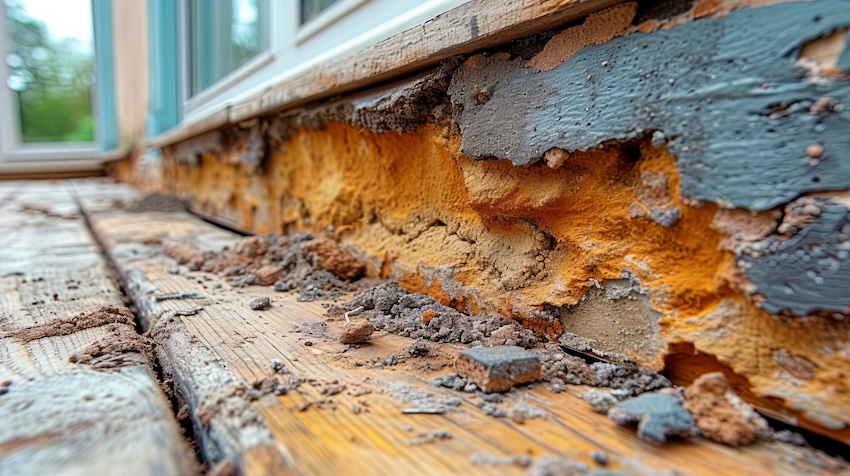Stopping the Invasion
Embracing Advanced Non-Chemical Barriers to Avoid Termite Damage
Sponsored by Polyguard | Presented by Dr. Gold, Jill Heidorf and Holly Beard
Webinar On-Demand
This webinar is part of the Waterproofing Academy
The threat to wood-framed structures from invasive pests like the Formosan subterranean termites remains a clear and present danger, especially for buildings along the Gulf Coast. Since they arrived in the 1960s, this non-native species has steadily marched North, extending their territory from Florida to Tennessee. Pests thrive in climate change conditions driven by excessive moisture and warm temperatures. Without a deliberate and thoughtful strategy, more homes will suffer extensive structural damage in their wake.
This AIA-accredited continuing education webinar explores the best practices and real-world benefits of combining non-chemical physical barrier termite protection with successful waterproofing strategies. From slab-on-grade construction to concrete block foundations, speakers will provide case studies, product insights, and field-tested solutions to keep the home pest-free and watertight.
The presentations will be followed by a moderated discussion.

Photo courtesy of Adobe
 |
Dr. Gold, is a Professor of Entomology and holds the Endowed Chair for Urban and Structural Entomology at Texas A&M University. This position has responsibility for Research, Teaching and Extension programs that involve the integrated management of insects associated with the near environment of humans and their pets. He served as the Director of the Water Center at the University of Nebraska-Lincoln, and as Head of the Department of Entomology at that institution. He began his professional career in Entomology at the University of Arizona in Tucson where he worked as an Extension Specialist. There, his program emphasized certification programs for certified pesticide applicators. He has his B.S. and M.S. degrees from the University of Utah, and a Ph.D. degree in Entomology from the University of California-Berkeley. He is a member of professional and scientific societies and organizations and has written many papers in both scientific journals and trade publications. |
 |
Jill Heidorf is the National Sales Manager for Polyguard Architects and Consultants. Jill’s background is 30 years in the building industry, working with Armstrong Flooring and Ceiling Products, W.R. Grace Construction Products and currently Polyguard Products. Jill spent 13 years training installers on correct installation of laminate, wood, VCT and vinyl flooring. Jill specialized in Air Barrier Envelope Solutions and below-grade Waterproofing with Grace for 7 years and transitioned to Polyguard to assist start-up and manage the TERM Barrier Systems Division. TERM provides waterproofing membranes + pesticide-free self-adhering membranes that offer permanent solutions, backed by years of science-based research. These membranes are incorporated into the building envelope at a surprising low cost for entry level. Jill enjoys spending time on jobsites and supervising installation of below-grade waterproofing barriers and air-barriers. Jill is a member of CSI and IIBEC. Jill has a BS from Purdue University and lives in McKinney, TX. with her husband Chris of 28 years and they have two daughters, both graduates of University of Arkansas. |
 |
Holly Beard, M.S., CPT USAR, CSI, WWYW is an entomologist by trade, is the Southeast Regional Technical Field Specialist for Polyguard Products’ Building & Construction Division. Holly’s background is 12 years in entomology with the last 8 years focusing on building envelope systems, waterproofing, and subterranean termite barriers with Polyguard. She is drawn to specifications and waterproofing systems that incorporate subterranean termite exclusion as integrated pest management representation in the building envelope. Managing research projects and participating in building code committees, she ensures code updates include integrated pest management tactics surrounding the building envelope. She enjoys and encourages everyone to reach out to her as a leading technical consultant in the AEC industry for waterproofing (DIV 07). Graduating from the University of Florida with her B.S. and M.S. in Entomology, Holly has experience with insect pests and how to prevent them. She is a Captain in the U.S. Army Reserve as a Civil Affairs Officer, building strategic partnerships. Holly is the CSI Honolulu Chapter Past President. She is an avid hiker, explorer, and workout enthusiast. |
Polyguard manufactures the toughest sealants & barrier systems for every construction project. Behind our quality products is an entire team of experts that are passionate about innovation and truly care about your success.
Originally published in Architectural Record
Originally published in August 2024
LEARNING OBJECTIVES
- Explain the history and destructive nature of the Formosan subterranean termite and how this pest is a more significant threat to the building environment than common pests.
- Identify the advantages of combining waterproofing strategies with termite prevention methods early in the design process.
- Describe the long-term sustainable benefits of using non-chemical physical barriers to address potential termite infestation.
- List real-world examples of projects that have employed termite prevention and waterproofing strategies to create safe, durable, and sustainable buildings.










